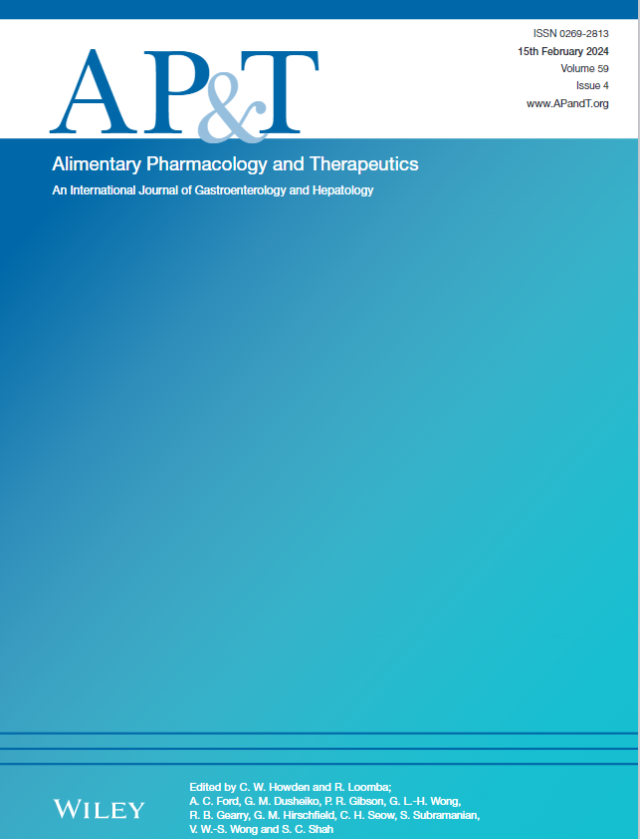揭示自身免疫性肝炎患者药物诱导的自身免疫样肝炎:一项多中心回顾性研究
IF 6.7
1区 医学
Q1 GASTROENTEROLOGY & HEPATOLOGY
引用次数: 0
摘要
背景和目的:急性或慢性暴露于药物或草药和膳食补充剂(HDS)可引起药物诱导的自身免疫性样肝炎(DI - ALH),这是一种类似自身免疫性肝炎(AIH)的自限性疾病。我们调查了AIH患者在诊断时的药物暴露率,以识别DI - ALH病例,并辨别预测AIH发展的特征。方法回顾性分析705例AIH患者。DI - ALH的定义采用已公布的标准。对DI - ALH和AIH的临床、生化、血清学和组织学数据进行分析,以确定每种表型的进化预测因子。结果大多数患者为女性(n = 496, 70%),中位年龄57岁,中位随访时间55个月。59% (n = 417)报告有药物或HDS暴露,8% (n = 58)符合DI - ALH标准。他汀类和HDS是最常见的罪魁祸首。DI - ALH患者在诊断时更常发生急性严重或暴发性肝炎(22%对12%,p = 0.013)和较高的转氨酶水平(ALT: 966对591,p = 0.001)。总的来说,97%的患者接受了免疫抑制。DI - ALH患者比i - AIH患者有更快的生化反应(4 vs. 5, p = 0.031),而只有29%的患者(n = 17)尝试停药。大约30% (n = 17)的DI - ALH病例在随访期间出现急性发作。无论是临床、组织学、血清学结果还是RUCAM和RECAM都不能预测DI - ALH的爆发。结论在临床实践中,di - ALH经常被低估,导致不必要的长期免疫抑制。药物与AIH之间的因果关系,以及试图停止治疗和长期随访,对于预防过度治疗相关的风险至关重要。本文章由计算机程序翻译,如有差异,请以英文原文为准。
Unveiling Drug‐Induced Autoimmune‐Like Hepatitis in Autoimmune Hepatitis Patients: A Multicenter Retrospective Study
Background and AimsAcute or chronic exposure to drugs or herbal and dietary supplements (HDS) can cause drug‐induced autoimmune‐like hepatitis (DI‐ALH), a self‐limiting condition resembling autoimmune hepatitis (AIH). We investigated the prevalence of drug exposure among AIH patients at diagnosis to recognise cases of DI‐ALH and discern features predicting AIH development.MethodsWe retrospectively included 705 patients diagnosed with AIH. DI‐ALH was defined using published criteria. The clinical, biochemical, serological, and histological data of DI‐ALH and AIH were analysed to identify predictors of the evolution of each phenotype.ResultsMost patients were female (n = 496, 70%), with a median age of 57 years and a median follow‐up of 55 months. A 59% (n = 417) reported exposure to drugs or HDS, and 8% (n = 58) fulfilled the criteria for DI‐ALH. Statins and HDS were the most common culprits. Patients with DI‐ALH more frequently had acute severe or fulminant hepatitis (22% vs. 12%, p = 0.013) and higher transaminase levels (ALT: 966 vs. 591, p = 0.001) at diagnosis. In total, 97% of the patients received immunosuppression. DI‐ALH patients had a faster biochemical response than i‐AIH patients (4 vs. 5, p = 0.031), while treatment withdrawal was attempted in only 29% (n = 17). Approximately 30% (n = 17) of DI‐ALH cases presented a flare during follow‐up. Neither clinical, histological, nor serological findings nor RUCAM and RECAM could predict a DI‐ALH flare.ConclusionsDI‐ALH is often under‐recognised in clinical practice, leading to unnecessary long‐term immunosuppression. A causal relationship between drugs and AIH, along with an attempt to withdraw treatment and long‐term follow‐up, is essential to prevent overtreatment‐associated risks.
求助全文
通过发布文献求助,成功后即可免费获取论文全文。
去求助
来源期刊
CiteScore
15.60
自引率
7.90%
发文量
527
审稿时长
3-6 weeks
期刊介绍:
Alimentary Pharmacology & Therapeutics is a global pharmacology journal focused on the impact of drugs on the human gastrointestinal and hepato-biliary systems. It covers a diverse range of topics, often with immediate clinical relevance to its readership.

 求助内容:
求助内容: 应助结果提醒方式:
应助结果提醒方式:


